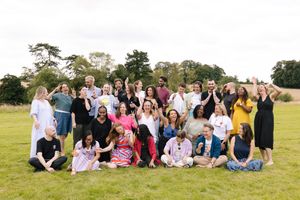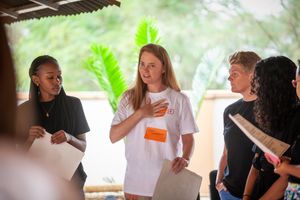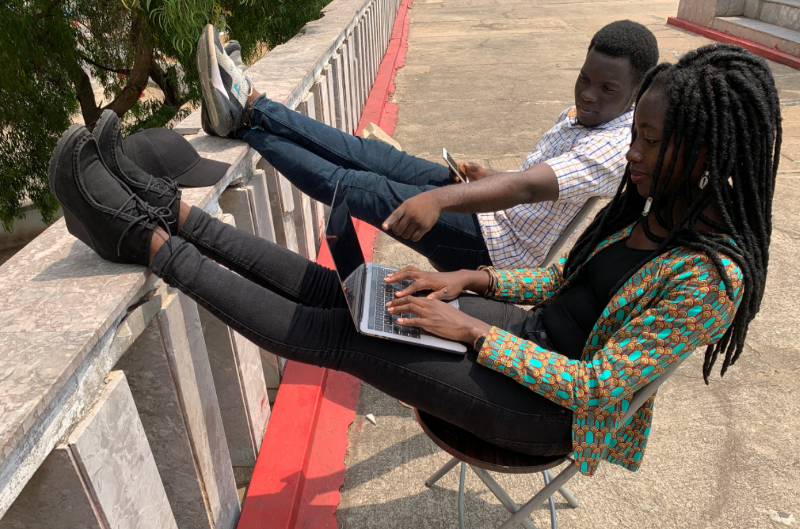
5 tips to nurture a self-supporting community
Think of a community that you’re a part of. Perhaps you’re involved in a more formal one, like a sports team or faith community, or maybe you just get together with a group of colleagues for a weekly Zoom coffee break.
Now imagine that you’re struggling with something. Maybe your fitness isn’t where you’d like it to be, or you’re facing a particular issue in your place of worship or work. What would you expect to happen? Perhaps you wait for the coach, rabbi or your most senior colleague to notice and step in to help.
This is a natural expectation, but how would it feel if it was one of your peers who came to help: who joined you for your morning run, prayed alongside you or asked you insightful questions to get to the root of the problem at work?
What would a community look like without a manager or a facilitator?
Communities come in all shapes and sizes; they can be organised like a sports team, facilitated like a faith community or take form organically like a weekly coffee break. But one thing is clear across this range: communities are stronger when their members support one another, and in many cases, communities are better off when they’re self-supporting.
At Brink, we believe the communities themselves are a powerful force for change. Just look at the Humanitarian Grand Challenges community, made up of innovators from social enterprises, businesses and NGOs. In order to improve the lives of people in conflict zones, they build and develop innovative solutions like SurgiBox: an ultraportable sterile field which fits into a backpack, enabling surgical teams to operate where they are needed, or Sehat Kahani’s Community Innovation Hub: an all female network in Pakistan providing quality healthcare to those in need, using telemedicine.
Beyond the organisations are individuals with wisdom
This community is a diverse group of people from across the globe: members of the Syrian diaspora working from the Global North to undertake life-saving work in Syria, small business owners in Nigeria operating in conflict-affected areas of the country, and teams in Kenya supporting water provision in Somalia.
Within each individual exists a huge amount of knowledge, expertise, support and inspiration. Enabling this group of people to connect, learn from one another, build partnerships and raise their collective voice has powerful potential.
Here are some tips to help build a self-supporting community, guided by five key questions. By being intentional about creating space for this community to thrive on its own agenda and at its own pace, the group can seek the partnerships which enable values-led work, solve the issues that are impacting their innovations, and lead the conversations that really matter in their contexts.
Question 1: How can you welcome people to your community in a way which creates intention for members to support one another?
Answer: Onboard with purpose
When a new cohort joined our community last year we wanted to know what they wanted, but also what they could offer themselves.To find out, we used a communal voting tool: Mentimeter. We set questions in one of our Zoom sessions, and as innovators submitted their answers they were able to see responses flooding in from across the global community.
This exercise helped us set the tone at the beginning: this is a community with a mutual exchange of support and a culture that celebrates collective wisdom.


A co-created onboarding activity marks the moment that new community members join this space and encourages innovators to virtually step forward, take up space and actively explore how the community can support them. We build an expectation that innovators contribute as well as gain. Starting with a rhythm of return means it’s easier to continue to do so in subsequent community moments, and this is essential to creating a supportive culture.
Question 2: Which habits are you building within your community and what expectations do they set?
Answer: Create clear expectations of how to be together as a community
At the beginning of each community workshop, I share this slide:

While the first two may be obvious Zoom etiquette by now, regularly introducing the third point has changed the dynamic as we spend time together as a community. See this exchange from our latest community event:

Instead of the participant count reducing as distractions and other priorities inevitably crop up for a group of people engaged in important work, the number of folk on the call fluctuates as people come and go. The chat is alive with notes as people step away for a moment or two, along with the usual contributions and questions.
Building habits such as this one develops an understanding across the community that this is a space where it matters how and when members show up, because they are here to support each other, not just attend a space where support is provided to them.
Question 3: How can you keep offers and asks fresh and engaging, especially when most communities are still meeting virtually?
Answer: Create playful mechanisms that enable connection
Since onboarding new members last year, we get together regularly as a community. Each time we explore what innovators want to ask of the network and what they want to offer.
Look at the Mentimeter images in Question 1 and see which possible connections you notice. This is what I see 👇
🌎 Connections to humanitarian agencies <> International exchanges
💸 Navigating early stage investment <> Funding
✋ Productisation <> Use cases
The flaw with this tool was that no one could see who’d offered what, and therefore didn’t know who to contact when offers and asks aligned. So we encouraged innovators to share in a couple more ways:

Then, we landed on something that worked really well: encouraging innovators to advocate for each other. Innovators joined breakout rooms in small groups to discuss their challenges and then posted on behalf of one another in our community Slack channel.
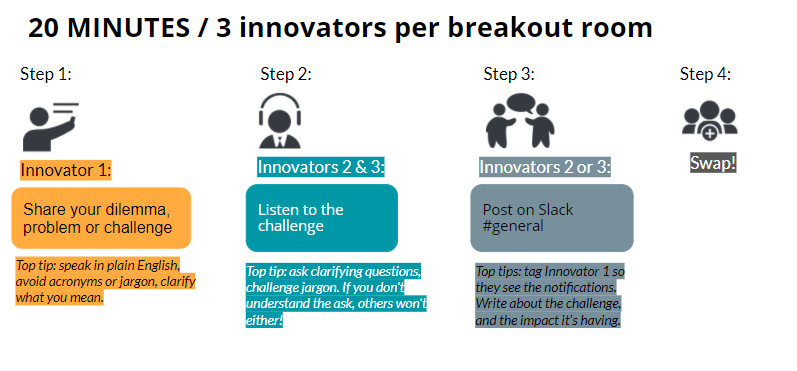
This resulted in a lively Slack feed, with innovators putting forward clear asks and creating multiple separate threads with recommendations, ideas and connections. The added bonus of Slack is that direct messaging is available directly in the platform, making it easy for innovators to connect directly around their needs.
Surfacing offers and asks within the community highlights the wealth of knowledge, expertise and support within the group. The outcomes of this are two-fold. Innovators have their needs met which helps to advance their vital work. As other community members see this, they are keen to experience similar support, and so contribute their own learning, experience and connections to the community.
Question 4: How do you and your co-workers reflect on what’s working and what could be even better?
Answer: Consider what needs to shift in you and your team
Our latest community get together showed what success could look like in terms of innovators sharing their asks with the community, but we still noticed a hesitancy of innovators to offer responses to each others’ challenges. The team stepped in to offer advice, connections and ideas, and nominate innovators who we thought might have something useful to share.
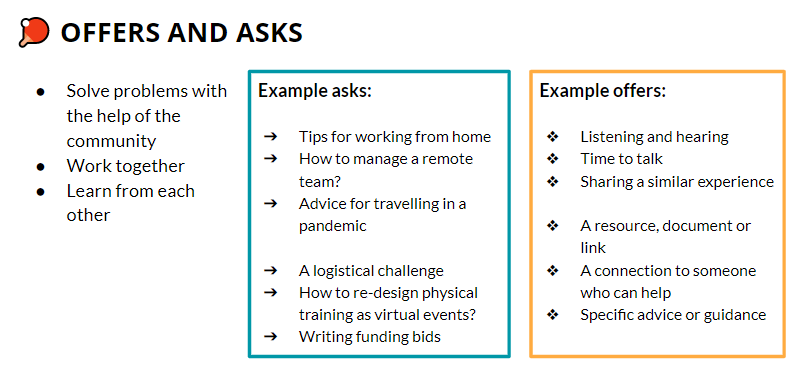
Looking ahead, we’re wondering how as a team we step back in these moments, giving space for innovators to step forward. Next, we’ll try:
- Running the same process for offers as for asks: innovators share their offers with others in break out rooms, these peers then advocate for those offers on Slack
- Allocating dedicated session time for innovators to look through their peers’ asks and respond with offers
- Starting the session with posting offers to the Slack, to then see which asks match up
Innovators are more likely to meet each others’ needs if there is an equal distribution of asks and offers within the community. This creates a self-sustaining pool of support, enabling innovators to meet each others’ needs beyond events, or the team’s capacity or expertise.
Question 5: What else do communities need to thrive?
Answer: this is work in progress for all of us. Let’s talk!
We can see that creating space for a community to thrive involves considered action at every point in its life span. From welcoming new members with intention around the active role they’ll play, to creating expectations about how the group behave together, to mechanisms that connect people for peer support, to the ways you and your team relate to the community, these moments are better with some thought, some testing and some fun!
There’s always more to learn about, with and for communities, and I look forward to sharing further learnings as we continue on this journey.
What would you add? Let me know by emailing me at️ [email protected].
